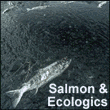forum
library
tutorial
contact

Fishing Pact Boosts Tribes' Chinook Catch
When Runs are Strong
by Jonathan Brinckman
The Oregonian, February 18, 2001
|
the film forum library tutorial contact |

|
Fishing Pact Boosts Tribes' Chinook Catch
by Jonathan Brinckman
|
The new agreement comes as Oregon and Washington expect
record-high fish levels this spring in the Columbia
Northwest tribes with treaty rights to Columbia River salmon have reached agreement on a new fishing plan that allows them to increase their harvest in years of abundance but requires they lower catch levels when numbers of wild fish are down.
The pact, after months of negotiation with the states of Oregon and Washington, comes just in time for what is predicted to be a record run of spring chinook.
More than 364,000 spring chinook are expected to cross Bonneville Dam in coming months, the highest number to cross the dam since its completion in 1938. The vast majority of those fish will be from hatcheries. But swimming with them will be Idaho-bound wild spring chinook that are protected under the Endangered Species Act.
Tribes will be allowed to catch 13 percent of those spring chinook, or more than 47,000 fish -- more than four times the 11,256 spring chinook caught last year by the tribes. Last year, also a banner year, was the first commercial spring chinook fishery for the tribes since 1977.
"If the forecast holds up, this will be a year of celebration," said Randy Settler, chairman of the Yakama Nation wildlife committee.
The agreement has a lifespan of five years. Significantly, it links tribal and sport fishing levels to the number of fish entering the Columbia River.
Conservationists hailed the link as key to allowing harvest of hatchery stocks while minimizing harm to wild fish.
"There are certainly going to be a lot of hatchery fish this spring," said Jim Myron, conservation director of Oregon Trout. "It is appropriate to figure out a way to catch more of those hatchery fish."
Still, Myron said he was concerned that the overall fishing level may be too high.
The agreement includes a sliding scale for harvest, with sport fishing levels starting at less than one-half of a percentage point when the run is below 25,000 fish and rising to 2 percent.
Tribal levels start at less than one-half of a percentage point and rise to 17 percent if the number of spring chinook entering the Columbia reaches 450,000.
The pact is intended to provide the cornerstone for a new, comprehensive Columbia River Fisheries Management Plan expected to be completed by December 2003. That plan is ordered by a federal court decision that upholds treaties signed in 1855 that guarantee fishing rights to four Columbia River tribes.
In addition to setting harvest levels, the agreement includes provisions that govern the operation of tribal hatcheries.
"The agreement reached this week is a milestone in that it marks the first time we have had a coastwide, conservation-based approach to wild salmon management," said Jeff Koenings, director of the Washington Department of Fish and Wildlife.
Ed Bowles, fish division director for the Oregon Department of Fish and Wildlife, said the agreement should help rebuild salmon stocks in good times and bad.
"We should be mindful that this extraordinary spring chinook return is a gift from nature and will occur on a more consistent basis only if appropriate actions are taken to recover these wild fish," Bowles said.
"This fisheries plan fits into a recovery plan very well."
learn more on topics covered in the film
see the video
read the script
learn the songs
discussion forum
